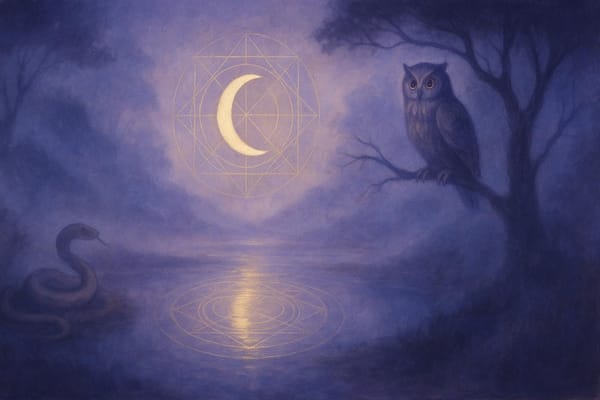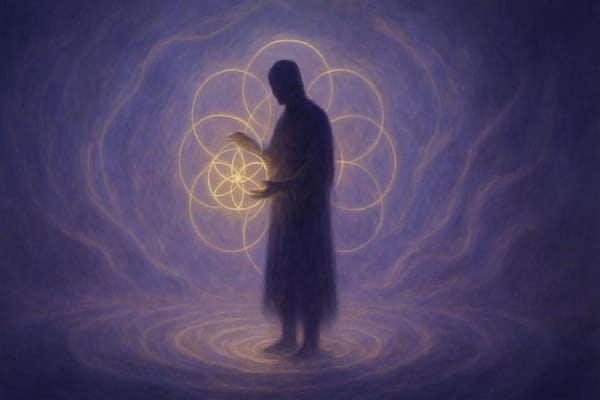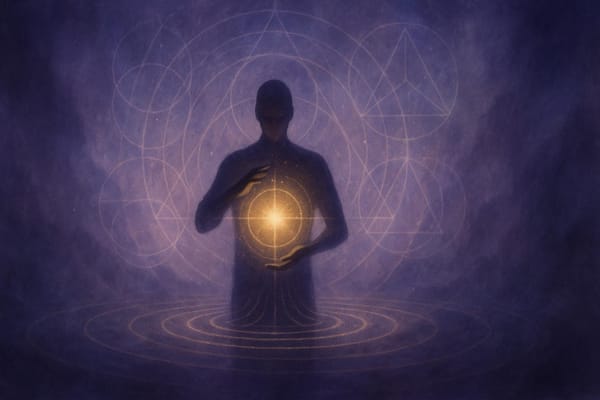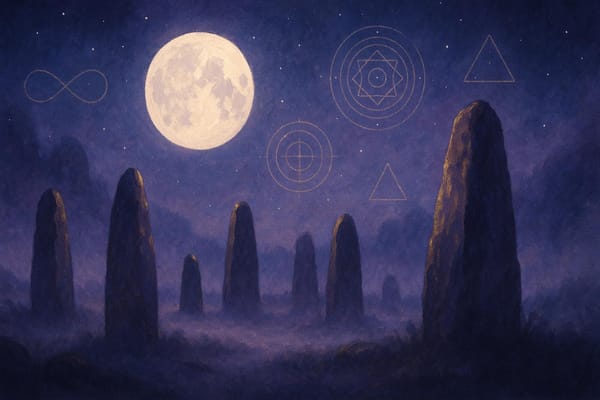Ego and the Illusion of Separation
Explore how the ego creates an illusion of separation, affecting our lives, relationships, and spiritual growth, and learn ways to foster unity.
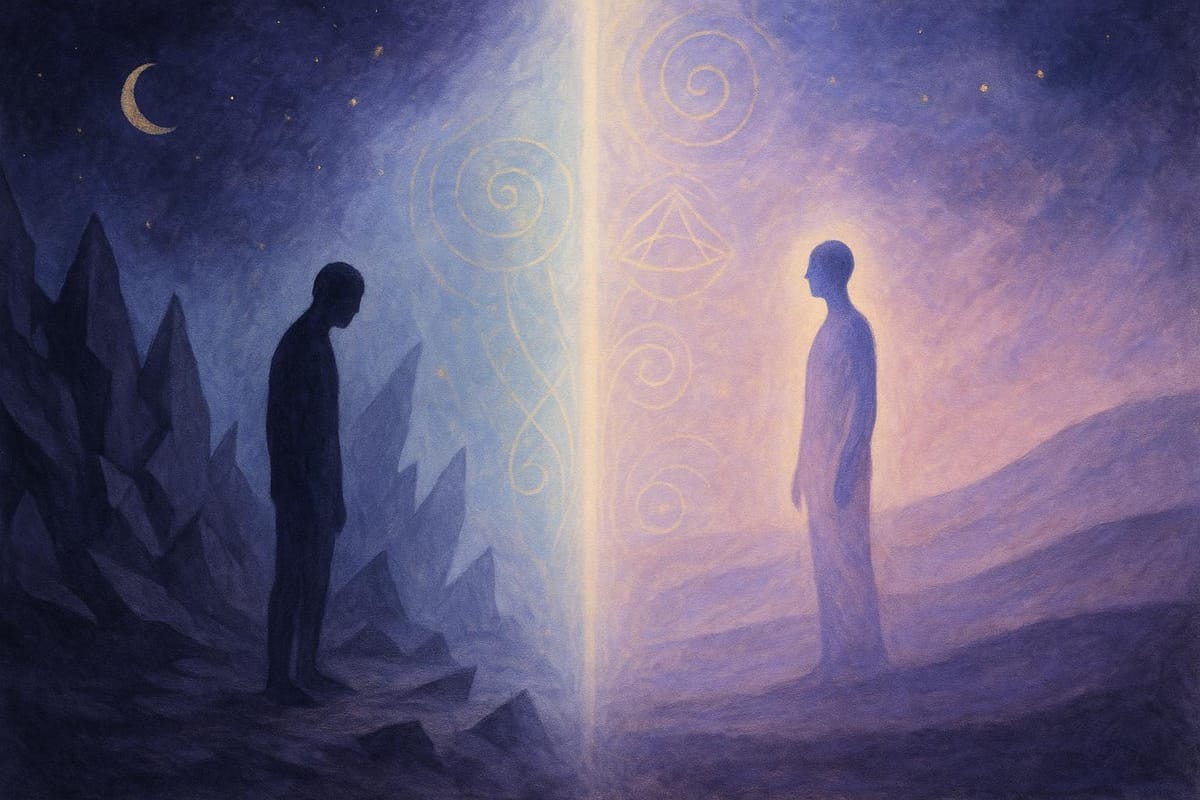
The ego shapes how we see ourselves and the world, but it often creates a false sense of separation. This illusion affects relationships, fosters fear, and limits spiritual growth.
Science and spirituality both suggest that this division is not real - quantum physics and ancient teachings highlight our inherent interconnectedness. Here's a quick breakdown of the key ideas and actionable steps:
- What the Ego Does: It filters experiences and builds boundaries, creating a "self vs. others" mindset.
- How It Affects Us: Fear, attachment, and judgment reinforce isolation and disconnection.
-
How to Move Beyond It:
- Self-Observation: Notice ego-driven patterns like negative self-talk or emotional triggers.
- Mindfulness: Practice meditation and present-moment awareness.
- Shadow Work: Accept and integrate suppressed parts of yourself.
- Daily Actions: Use body scanning, mindful breathing, and acts of kindness to reduce separation.
The goal is not to destroy the ego but to shift your relationship with it, fostering unity and deeper connection with life. As science and spirituality both reveal, separation is an illusion - embracing this truth can lead to profound transformation.
How the Ego Creates Separation
The Ego's Protection System
The ego works as a built-in survival tool, constantly scanning for potential threats and building walls to protect us from harm. While this system is crucial for staying safe, when it becomes overactive, it can lead to feelings of isolation and disconnection from others.
At its heart, the ego operates with a "WAM" mindset - short for "What About Me!". This self-focused lens strengthens the illusion of separation by constantly prioritizing self-preservation and self-interest.
To maintain this protective stance, the ego relies on several defense mechanisms that distort how we see the world:
| Defense Mechanism | How It Creates Separation |
|---|---|
| Denial | Blocks out aspects of reality that feel threatening |
| Projection | Shifts personal insecurities onto others |
| Rationalization | Justifies actions or beliefs to avoid facing uncomfortable truths |
| Displacement | Redirects emotions toward safer outlets, creating emotional distance |
These defenses, while protective, often lead to a growing divide between ourselves and others.
The Split Between Self and Other
The ego's defense mechanisms lay the groundwork for a more profound separation between "self" and "other."
One way the ego deepens this divide is through a process called splitting. This psychological habit oversimplifies people and experiences into rigid categories, such as "good" or "bad", stripping away the complexity and nuance of human relationships.
Research shows that this tendency to split is closely tied to an unstable sense of self and lower self-esteem. The ego reinforces these divisions in several ways:
- Drawing strict boundaries around personal identity
- Highlighting differences instead of shared connections
- Crafting a narrative that reinforces the idea of being separate from others
"As soon as intellect has acquired enough data, the ego now takes ownership and defends it. The separation has begun!"
Fear and Attachment Patterns
Fear acts as the primary fuel for the ego. To protect itself, the ego oscillates between fear and desire, creating emotional habits that isolate us further.
These habits often appear as:
- A sense of scarcity and competition
- Quick judgments of others
- Clinging to material things or relationships
- Fear of uncertainty and losing control
"The ego is the false self - born out of fear and defensiveness."
When these attachments are threatened, they trigger emotional pain, reinforcing the feeling of separation. By resisting uncertainty, the ego keeps us from experiencing the natural flow and interconnectedness of life.
The Illusion of Separation
Moving Beyond the Ego
Now that we’ve explored how the ego creates separation, let’s dive into actionable practices that can help dissolve these barriers and encourage a deeper sense of connection.
Starting with Self-Observation
Self-observation is a powerful way to create space between your true self and the automatic responses driven by the ego. It’s about cultivating an "even hovering attention" - a state where you can notice your inner experiences without getting swept up in them. To begin, focus on these specific areas:
| Observation Focus | Ego Pattern | Practice |
|---|---|---|
| Speech Patterns | Overusing "I" statements | Pay attention to what follows every "I" in your conversations. |
| Emotional Triggers | Intense emotional reactions | Track scenarios that spark strong emotions and reflect on their root causes. |
| Self-Talk | Negative inner commentary | Notice and gradually reduce self-critical or self-deprecating remarks. |
| Future Predictions | Assuming worst-case scenarios | Observe when you’re predicting negative outcomes and challenge those ideas. |
Working with the Shadow
Shadow work is about facing the parts of yourself that you’ve suppressed or denied. These hidden aspects often fuel the ego’s tendency to create divisions, both internally and externally.
By acknowledging and integrating these parts, you can reduce the ego’s influence and gain a more complete understanding of yourself.
This process isn’t about rejection - it’s about acceptance. It requires courage to face uncomfortable truths and compassion to embrace them.
"Unless you learn to face your own shadows, you will continue to see them in others, because the world outside of you is only a reflection of the world inside of you." – The Minds Journal
Tools for Transcendence
Moving past the ego doesn’t mean erasing it; it’s about shifting your perspective and developing a healthier relationship with this part of yourself. Here are some tools to help you along the way:
-
Mindful Ego Dropping
Bring your attention to your bodily sensations and gradually expand your awareness outward. This practice encourages a conscious release of the ego’s sense of separation. -
Ego Naming Practice
Assign a name to your ego. This simple yet effective technique helps you recognize when your ego is taking charge, making it easier to observe its influence without identifying with it. -
Trigger Awareness Protocol
When something triggers you, pause and notice the physical sensation it creates. Identify the ego’s response, acknowledge the underlying fear, and consciously choose how to react.
The goal isn’t to destroy the ego but to redefine your relationship with it. Over time, these practices can loosen the ego’s grip, allowing you to experience a deeper connection with life as a whole. By shifting your awareness and embracing unity, you open the door to profound spiritual growth.
Science and Spirit on Separation
Quantum Physics and Unity
Quantum physics challenges the very idea of separation, revealing it to be an illusion. At the quantum level, phenomena like quantum entanglement show that particles remain interconnected, no matter how far apart they are. This connection is instantaneous and defies traditional notions of space and time.
In 2022, Alain Aspect, John Clauser, and Anton Zeilinger were awarded the Nobel Prize in Physics for their groundbreaking work with entangled photons. Their experiments confirmed that particles can influence one another instantly, even across vast distances - an observation that shakes the foundations of classical physics.
| Quantum Principle | Classical View | Quantum Reality |
|---|---|---|
| Entanglement | Objects exist independently | Particles share instantaneous connections |
| Observer Effect | Observation has no impact | Conscious observation alters outcomes |
| Superposition | Objects exist in one state | Multiple states coexist simultaneously |
These quantum discoveries echo ancient spiritual teachings, which have long emphasized the interconnected nature of existence.
Mystic Views on Oneness
Ancient spiritual traditions have also taught that separation is a distortion of reality. Many of these teachings suggest that the perception of separateness is a construct of the ego, limiting our understanding of the world.
"The evolution of existence is one. The divine order is one. All beings great and small are subject to one law and one order."
- Abdu'l-Baha
Eastern philosophies, such as Advaita Vedanta, describe reality as non-dual, where the distinctions between self and universe dissolve into a unified whole. This perspective not only offers a profound way of understanding existence but also suggests practical ways to foster deeper connections with others and ourselves.
Interestingly, this timeless wisdom aligns with modern interpretations like simulation theory, which further challenge the boundaries of perceived reality.
Simulation Theory Perspectives
Simulation theory takes the idea of separation one step further, suggesting that the ego creates a personal simulation based on trauma, survival instincts, and deeply held beliefs. This simulation fosters a false sense of separateness.
"What if the simulation isn't 'out there?' What if it's not the universe that's fake - but your ego's version of it?"
- Tony Halligan
This perspective aligns with both quantum physics and mystical insights, reinforcing the idea that separation is not a fundamental aspect of reality. By recognizing and transcending these mental constructs, we can begin to experience the interconnectedness that lies beneath.
Together, these scientific and spiritual viewpoints reveal that the sense of separation we often feel is not intrinsic to existence - it's a product of consciousness and perception.
Daily Methods to Reduce Separation
Basic Meditation Steps
Meditation is a powerful way to break down the sense of separation we often feel. Here’s a simple sequence to help you get started:
-
Foundation Practice
Begin with 10–15 minutes of silent meditation. Sit comfortably, close your eyes, and focus on your natural breathing. When your mind starts to wander, gently acknowledge those thoughts without judgment and return your attention to your breath. -
Deepening Awareness
Once you feel more settled, broaden your focus to include physical sensations. Pay attention to how the boundaries between your internal experience and the external world start to blur. -
Advanced Integration
To take it further, silently repeat the phrase "I AM." This practice helps connect your individual sense of self with a more universal awareness.
These steps provide a foundation for weaving mindfulness into your everyday life.
Simple Daily Practices
You don’t need to reserve mindfulness for formal meditation sessions - small, intentional actions throughout the day can also help dissolve feelings of separation. Here are a few simple techniques:
| Practice | Method | Benefit |
|---|---|---|
| Body Scanning | Pause to notice physical sensations | Keeps you grounded in the present |
| Mindful Breathing | Take a few conscious breaths before tasks | Lowers reactive, ego-driven responses |
| Loving-Kindness | Send positive thoughts to others | Erodes the sense of "me versus them" |
"Unity consciousness manifests as the sense of oneness, compassion, love, and respect, both for human beings and for nature."
- Jing Lin, Professor of International Education at University of Maryland
Testing Reality
Mindfulness can also help you challenge and reframe the mental barriers that fuel separation. Reality-testing exercises are a practical way to do this.
Mindful Observation and Reframing
Pay attention to the thought patterns that reinforce feelings of separation, especially those rooted in judgment. For example, if you catch yourself thinking, "I'm bound to be alone", try reframing it as, "I am embracing a period of self-growth". With regular practice, this kind of self-observation can weaken the ego’s grip.
"Almost all of our problems are caused by our self-concern."
"Once you have had a taste of it, you will grow in presence power, and the ego will loosen its grip on you."
The key to success lies in consistency. Small, steady efforts over time can lead to profound shifts.
Conclusion: Living in Unity
Reflecting on Key Insights
Letting go of the ego allows us to uncover the deep truth of our interconnected existence. By cultivating awareness and practicing consistently, we can tap into the profound experience of unity consciousness. As Eckhart Tolle wisely puts it:
"Once you have had a taste of it, you will grow in presence power, and the ego will loosen its grip on you"
Here's a quick comparison to highlight the shift from ego-driven traits to unity consciousness:
| Ego Traits | Unity Consciousness |
|---|---|
| Judgment and criticism | Acceptance and compassion |
| Self-concern | Service to others |
| Separation and isolation | Interconnection and belonging |
| Fear-based reactions | Love-based responses |
These distinctions remind us of the transformative power of unity in our lives.
Steps to Embrace Unity
To deepen your connection to unity consciousness, focus on integrating simple yet impactful practices into your daily life. Consider these approaches:
- Mindful Awareness: Stay present and observe your thoughts without judgment.
- Acts of Service: Prioritize helping others and fostering a sense of community.
- Engaging in the Moment: Fully immerse yourself in whatever you're doing.
- Compassionate Actions: Respond to situations with kindness and understanding.
As Gurudev Sri Sri Ravi Shankar beautifully states:
"Even if you win in ego, it is a loss. Even if you lose in love, it's a victory!"
Every conscious choice to act with love and compassion weakens the illusion of separateness. In the words of Professor Jing Lin:
"Unity consciousness manifests as the sense of oneness, compassion, love, and respect, both for human beings and for nature"
Ready to step beyond information and into activation?
This blog is part of an ongoing personal study — a living exploration of simulation theory, manifestation, and reality-bending. If something here resonated, you’re not here by accident.
Join the journey.
Get deeper insights, tools, and transmissions delivered to your inbox: no noise, no fluff — just real signals for seekers.
FAQs
How can I tell when my ego is creating a sense of separation in my daily life?
You can spot when your ego is driving a wedge between you and others by tuning into your emotional and mental responses. Emotions like irritation, feeling defensive, or even a sense of being "better than" often signal that your ego is in play.
For instance, if someone’s comment leaves you feeling offended or undervalued, it’s likely your ego reacting to what it sees as a challenge to your self-image.
Pay attention to recurring thoughts that make you take things personally, compare yourself to others, or feel isolated. These thought patterns build the illusion of separation and create walls between you and the people around you.
By cultivating self-awareness and observing these reactions without judging them, you can start to recognize them for what they truly are - stories crafted by the ego. This awareness can help you move toward a stronger sense of connection and harmony.
How can I incorporate shadow work into my personal growth journey?
To bring shadow work into your personal growth journey, begin by uncovering the parts of yourself that you usually shy away from or bury deep. These could be thoughts, emotions, or behaviors that stir up discomfort, guilt, or even shame.
A great way to start is by journaling - it provides a safe space to dive into these hidden aspects and reflect on them honestly.
After identifying these traits, the next step is to embrace and integrate them as part of who you are. Mindfulness can help you observe these parts without jumping to judgment, while self-compassion encourages you to meet them with understanding and kindness.
Tools like guided meditations or working with a therapist familiar with shadow work can also make a big difference, offering guidance and helping you uncover deeper truths. With time and patience, this practice can enhance your self-awareness and support meaningful personal growth.
How does quantum physics reveal the interconnected nature of the universe and debunk the illusion of separation?
Quantum physics provides fascinating insights into the interconnected fabric of reality, especially through the phenomenon of quantum entanglement.
When two particles become entangled, the state of one particle instantly affects the state of the other, regardless of the distance between them. This mind-bending behavior challenges the traditional understanding of separateness and suggests that the universe functions as a deeply unified system.
This idea of interconnectedness also questions the boundaries we often perceive in our everyday lives. The divisions we see between ourselves and others, or even between mind and matter, might just be illusions shaped by our perception.
At its heart, quantum physics unveils a profound truth: everything in the universe is intricately connected, pointing to a universal unity that goes beyond the limits of space and time.

